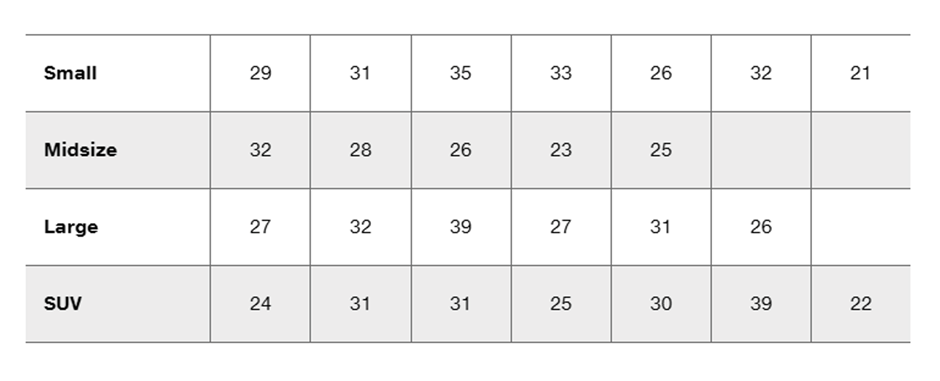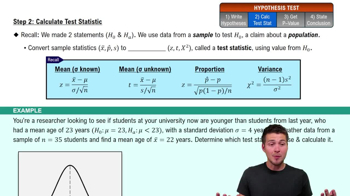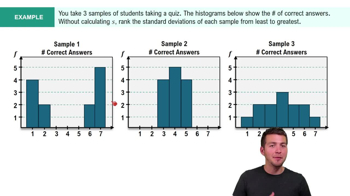Rank Sum After ranking the combined list of female heights given in Exercise 1, find the sum of the ranks for the ANSUR I sample.
Table of contents
- 1. Intro to Stats and Collecting Data1h 14m
- 2. Describing Data with Tables and Graphs1h 55m
- 3. Describing Data Numerically2h 5m
- 4. Probability2h 16m
- 5. Binomial Distribution & Discrete Random Variables3h 6m
- 6. Normal Distribution and Continuous Random Variables2h 11m
- 7. Sampling Distributions & Confidence Intervals: Mean3h 23m
- Sampling Distribution of the Sample Mean and Central Limit Theorem19m
- Distribution of Sample Mean - Excel23m
- Introduction to Confidence Intervals15m
- Confidence Intervals for Population Mean1h 18m
- Determining the Minimum Sample Size Required12m
- Finding Probabilities and T Critical Values - Excel28m
- Confidence Intervals for Population Means - Excel25m
- 8. Sampling Distributions & Confidence Intervals: Proportion1h 12m
- 9. Hypothesis Testing for One Sample3h 29m
- 10. Hypothesis Testing for Two Samples4h 50m
- Two Proportions1h 13m
- Two Proportions Hypothesis Test - Excel28m
- Two Means - Unknown, Unequal Variance1h 3m
- Two Means - Unknown Variances Hypothesis Test - Excel12m
- Two Means - Unknown, Equal Variance15m
- Two Means - Unknown, Equal Variances Hypothesis Test - Excel9m
- Two Means - Known Variance12m
- Two Means - Sigma Known Hypothesis Test - Excel21m
- Two Means - Matched Pairs (Dependent Samples)42m
- Matched Pairs Hypothesis Test - Excel12m
- 11. Correlation1h 6m
- 12. Regression1h 50m
- 13. Chi-Square Tests & Goodness of Fit1h 57m
- 14. ANOVA1h 57m
9. Hypothesis Testing for One Sample
Steps in Hypothesis Testing
Problem 13.5.1
Textbook Question
HIC Measurements Listed below are head injury criterion (HIC) measurements from crash tests of small, midsize, large, and SUV vehicles. In using the Kruskal-Wallis test, we must rank all of the data combined, and then we must find the sum of the ranks for each sample. Find the sum of the ranks for each of the four samples.

 Verified step by step guidance
Verified step by step guidance1
Step 1: Combine all the HIC measurements from the four samples (Small, Midsize, Large, SUV) into a single list. This will include all the values from the table: [29, 31, 35, 33, 26, 32, 21, 32, 28, 26, 23, 25, 27, 32, 39, 27, 31, 26, 24, 31, 31, 25, 30, 39, 22].
Step 2: Rank all the combined data in ascending order. Assign ranks to the values, starting with 1 for the smallest value. If there are ties (i.e., repeated values), assign the average rank to the tied values. For example, if two values are tied at positions 3 and 4, both will receive a rank of (3+4)/2 = 3.5.
Step 3: Separate the ranked data back into their respective samples (Small, Midsize, Large, SUV). Each sample will now have ranks corresponding to its original values.
Step 4: Calculate the sum of the ranks for each sample. Add up all the ranks for the values in each sample (Small, Midsize, Large, SUV).
Step 5: Verify the calculations by ensuring the total sum of ranks across all samples equals the sum of integers from 1 to the total number of data points (n). For example, if there are 25 data points, the sum of ranks should equal n(n+1)/2 = 25(25+1)/2 = 325.
 Verified video answer for a similar problem:
Verified video answer for a similar problem:This video solution was recommended by our tutors as helpful for the problem above
Video duration:
6mPlay a video:
Was this helpful?
Key Concepts
Here are the essential concepts you must grasp in order to answer the question correctly.
Kruskal-Wallis Test
The Kruskal-Wallis test is a non-parametric statistical method used to compare three or more independent groups. It assesses whether the samples originate from the same distribution by ranking all data points combined and analyzing the rank sums. This test is particularly useful when the assumptions of ANOVA are not met, such as when data is not normally distributed.
Recommended video:
Guided course

Step 2: Calculate Test Statistic
Ranking Data
Ranking data involves ordering the values from lowest to highest and assigning a rank to each value. In the context of the Kruskal-Wallis test, all data points from different groups are combined and ranked together, which allows for a comparison of the groups based on their ranks rather than their raw scores. This process is crucial for the test's calculations.
Recommended video:
Guided course

Visualizing Qualitative vs. Quantitative Data
Sum of Ranks
The sum of ranks is the total of the ranks assigned to the data points within each group. In the Kruskal-Wallis test, calculating the sum of ranks for each sample is essential for determining whether there are significant differences between the groups. This sum is then used in the test statistic to evaluate the null hypothesis regarding the equality of the groups.
Recommended video:
Guided course

Calculating Standard Deviation Example 1

 6:21m
6:21mWatch next
Master Step 1: Write Hypotheses with a bite sized video explanation from Patrick
Start learningRelated Videos
Related Practice
